
View of modern Cartagena from the fortress of San Felipe de Barajas
I have wanted to visit Columbia for years, particularly after we did an episode of the Amateur Traveler Podcast about Cartagena and Northern Columbia. With a gap in my schedule, I had it down to Cartagena for six nights. Here is what I would do again and how you can have an even better trip than I did.
When to visit Cartagena

Graph of the average temperatures in Fahrenheit and precipitation in inches for Cartagena, Colombia, by month.
After arriving in Cartegena, one of the first things I found was that I had come at the wrong time of the year. The temperature in Cartagena is pretty consistent all year round, with more rain in September and October. Rein wasn’t really the problem, though. The problem was that I also met much higher humidity. The days that it was cloudy and rain rainy were lovely, but the days of high sunshine and high humidity were brutal. So, I would avoid the months of September and October in Cartagena and come some other time.
Tips for Travel to Cartegena
I highly recommend you have a data plan when you visit Cartegena. This will allow you to contact tour guides, get navigation while you walk around, and use a translation app. If your cell service does not include free international coverage, you can get an eSim if you have a modern cell phone. With an eSim, you can still have your home number turned on but get local service. To purchase an eSim, go to Holyfly.
Cartegena’s Old City Walking Tour
Cartagena’s Old City, a UNESCO World Heritage Site, is enclosed by ancient walls that once (mostly) protected the city from pirates and invaders. I spent 3 nights inside the old city at the beautiful Hotel Casa La Factoria.
The first thing I would recommend is to take a walking tour of the Old City. The tour typically lasts about 2 hours and 45 minutes, and it’s led by knowledgeable guides who bring Cartagena’s history to life with vivid storytelling.
You can take a free walking tour, as I did, although this may be a rather large group, or you can book a private tour, which will give you more flexibility on the itinerary.
Camellón de los Mártires Square
My walking tour started at the Camellón de los Mártires Square or the monument for the 9 martyrs. These were revolutionaries in the war for independence for Spain who were executed on this spot.
Clock Tower Monument
Known as the gateway to the Old City, the Clock Tower (Torre del Reloj) is one of Cartagena’s most recognizable landmarks. During my visit, it was under renovation. This area is always filled with vendors selling things like hats and cold drinks.
Plaza de los Coches (Square of the Carriages)
This bustling square was once the city’s slave market. A statue in the square depicts conquistador Pedro de Heredia, who founded the city in 1533. What it fails to depict is India Catalina, a young native woman who was kidnapped from these shores as a child and returned as the interpreter for Heredia. If you look at the souvenir stands near this square, you will easily find small statues of her.
Plaza de la Aduana
The largest plaza in the Old City was historically the hub of commerce, where goods were imported and exported during the colonial period. It was also used as a parade ground. The old customs house here is now the city hall. The square has a statue of Christopher Columbus.
In this square and elsewhere in the city, you will likely see women from San Basilio de Palenque in colorful costumes. Palenque is a historic Afro-Colombian village and the first free African town in the Americas. It was founded by escaped slaves in the 16th century. Before the Covid pandemic, these women would sell fresh fruit, but these days, they make their living off the money they get from you when you take their photo. Ask before you photograph them.
Plaza de San Pedro Claver
Named after the patron saint of slaves, Saint Peter Claver, this square is home to the stunning San Pedro Claver Church. Saint Peter was a local Jesuit priest who would meet the slave ships when they arrived and care for the slaves in the greatest need of medical attention.
Two museums are on the same block as the church. To the left of the church is the Jesuits’ museum about San Pedro Claver, and behind the church is the Caribbean Naval Museum. Learn about the city’s naval history, including its role in defending against pirates and foreign invaders.
A statue outside the church pictures the priest with an African slave. Our tour guide told us this was one of the African interpreters who worked with Peter. This may be the case, as he had up to seven interpreters who spoke different African languages. San Pedro Claver is now the patron saint of slaves and Colombia.
Bastion of San Ignacio
Near the San Pedro Claver Church is the Bastion of San Ignacio. Part of the city’s fortifications, the bastion offers panoramic views of the Caribbean Sea and Cartagena’s skyline.
Plaza de Bolívar
One of the few green spaces in the old city is this plaza dedicated to Bolivar the Liberator, which contains his statue.
Behind the park is the Museum of Cartagena de Indias. This is housed in the Palace of the Inquisition, which was the center of the Spanish Inquisition in the area. The museum documents that little piece of history… that no one expected.
In front of the park is the Museo del Oro Zenú, a free museum about the pre-Columbian people of Cartagena and their crafts.
Plaza Santo Domingo
A charming square is in front of Cartegena’s oldest church. Here, you can relax at outdoor cafés while admiring the Botero sculpture, “Gertrudis.” According to our guide, if you touch this voluptuous nude woman statue on her breasts, you will get luck. If you touch her feet, you will continue traveling. If you touch her back, you will return to Cartegena. It would appear many people in Cartegena are in search of luck.
Bastion of Santo Domingo
Another defensive stronghold that highlights Cartagena’s military architecture. It will come in particularly handy should the old city ever be invaded by the residents of the highrises in the Bocagrande neighborhood.
This tour provides an excellent overview of Cartagena’s colonial heritage, from its beautiful squares and churches to the fortifications that once protected the city. It also stops at a shop to try some local products and includes a salsa lesson.
Other Sites in the Old City
House of Simon Bolivar
On Calle 36 is the first house where Simon Bolivar, the liberator, lived while in the city. Like many of the houses from the colonial era, they had large doors and smaller inset doors. It also has a large brass door knocker. The knocker indicated the occupation and status of the owner. A lion’s head indicated a soldier. A fish indicated a sailor or some other trade related to the sea. A lizard indicated royalty. The clergy would have praying hands.
- Get a universal plug adapter
- Get an eSim to be able to use your smartphone abroad.
- Get a Car Rental
- Search for Great Tours HERE
- Book Your Accommodation HERE
- Buy Travel Insurance

Horse Drawn Carriages
Except in the hottest part of the day, you can often see carriages pulling tourists through town. These carriages above are at the Plaza de la Aduana.
Las Bóvedas de Santa Clara
In the northeastmost corner of the old city walls, you can find some of the best shops for local goods at Las Bóvedas de Santa Clara. If high-end shopping is more your thing, there is a modern mall two blocks away at the La Serrezuela Mall.
Restaurants
There are many restaurants in the old town and nearby Getsemani. One thing that is harder to find in the old city is a more traditional Colombian meal. There are many international restaurants. One of my tour guide’s favorite restaurants, which she said was also a favorite with locals, is Crepes & Waffles. While not local, the restaurant, I was told, is popular with locals in part because only hires single mothers as its wait staff.
Getsemani Walking Tour: Art, Culture, and Resistance
While the Old City is steeped in colonial history, the Getsemani neighborhood offers a completely different vibe. Known for its vibrant street art and bohemian culture, Getsemani has a rich history of resistance, having played a crucial role in Cartagena’s fight for independence.
The walking tour of Getsemani takes you on a journey through the neighborhood’s colorful streets, where murals and graffiti tell the stories of the community’s struggles and triumphs. As with the old town, both free walking tours and private tours are available.
Centennial Park
A lush green space that marks the entrance to Getsemani, offering a serene spot to begin your journey. Look up as you walk through the park, and you might spot a monkey or a sloth.
Street of the Umbrellas
A whimsical alley lined with colorful umbrellas, perfect for a photo-op and a reminder of Getsemani’s creative spirit. It might be time to replace some of these umbrellas, though.
Street Art
The highlight of the Getsemani tour is the colorful street art.
Some of the art is selling things, some is featuring local celebrities.
One colorful sign encourages you to live aqui y ahora, “here and now.”
Colorful Art
Some of the art in Getsemani is for sale, so you can take it home and remember this colorful neighborhood.
Iglesia de la Trinidad
The second oldest church in Cartagena is in Getsemani. Iglesia de la Trinidad was more of a working-class church. The square in front of the church is lively in the evenings and one of the better spots for street food in the neighborhood.
The Getsemani tour highlights the neighborhood’s role as a center of art, culture, and political resistance. It’s a perfect way to experience Cartagena’s more contemporary, artistic side.
Castillo San Felipe de Barajas
Castillo San Felipe de Barajas, standing majestically on the Hill of San Lázaro in Cartagena, Colombia, is one of the most impressive examples of Spanish colonial military architecture. After Sir Francis Drake captured and held the city for almost 2 months in 1586, the Spanish decided that better defenses were needed. Construction started in 1656, and it was designed to protect the city from invasions by pirates and hostile forces.
This imposing fortress is strategically positioned to overlook Cartagena’s historic center and harbor, giving it a commanding presence and essential line of defense for the Caribbean coast.
The fortress played a crucial role during several sieges, most notably the 1741 Battle of Cartagena de Indias, where the outnumbered Spanish forces successfully defended the city against a major British invasion led by Admiral Edward Vernon.
Today, Castillo San Felipe de Barajas is a must-visit landmark for anyone traveling to Cartagena. Visitors can learn about its storied history through various exhibits and enjoy sweeping views of the city from its highest points. While I walked to the fortress from the old town, I would recommend a taxi or an Uber.
Beaches
During my stay, I spent three days exploring one of Cartagena’s Beaches. I stayed at the Hotel Las Américas in the La Boquilla neighborhood, on the other side of the airport from the Old City. The beach at La Boquilla is 2.5 to 3 miles long and is popular with locals and Spanish-speaking tourists.
This beach is not Colombia’s most beautiful beach. It does not have the white sands of Australia, the pink sands of Bermuda, or the green or black sands of Hawaii. I probably flew over many lovelier beaches on my way to Colombia. That being said, I was glad that I extended my visit to appreciate the local beaches and the resort scene.
I appreciate a job well done, like the vendor renting beach chairs and umbrellas and raking the beach clean each morning. I love hearing the sound of a little bell. The man who sells ice cream pushes his cart through the edge of the surf. Everything seems a little more laid-back. The people selling drinks will wait for you to come because they know they have what you want. The beach is full of families and locals. The water is wonderfully cool and refreshing without being cold. If you visit on the hottest time of the year, a few days at the beach can be quite refreshing.
Past the high-rise hotels is a more local beach. Right around where the local beach starts, you can find a few shops that will teach you how to parasail.
You can rent an umbrella from the Hotel Las Américas and two chairs for about $25 daily. You might get a cheaper option further down the beach.
Or you can sit by the rooftop infinity pool at Hotel Las Américas, drink a Piña Colada, and work on a newsletter for Amateur Traveler while you watch the planes land at the nearby airport.
Side Trips from Cartegena
- Visit San Basilio de Palenque: This city was founded by escaped slaves and still has a strong connection to Africa.
- Visit the Rosario Islands: For a day of relaxation, take a boat tour to the Rosario Islands, where you can enjoy crystal-clear waters, white sandy beaches, and vibrant coral reefs.
Conclusion
Cartagena effortlessly blends the old with the new. Whether you marvel at the colonial architecture in the Old City or admire the street art in Getsemani, there’s something here for every traveler. Explore, sample, savor, and relax in this beautiful gateway city to Colombia.
+Chris Christensen | @chris2x | facebook























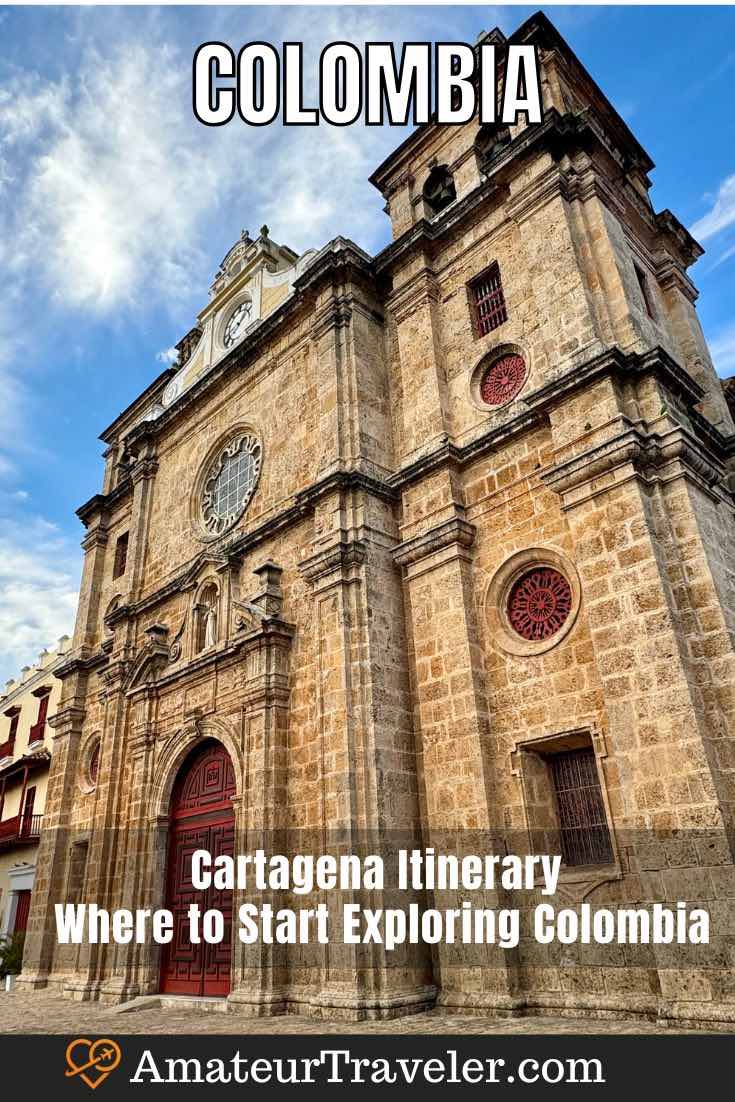
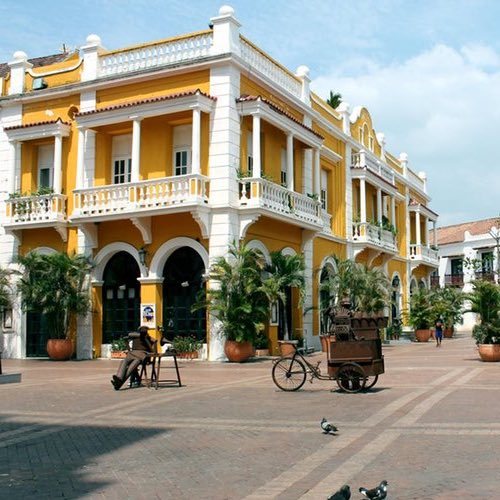 What You Need to Know About Cartagena, Colombia
What You Need to Know About Cartagena, Colombia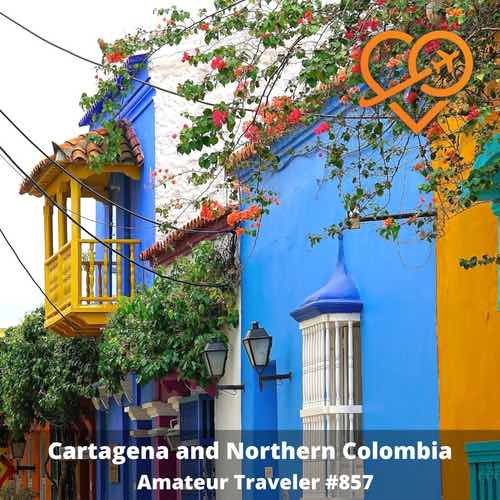 Travel to Cartagena and Northern Colombia – Episode 857
Travel to Cartagena and Northern Colombia – Episode 857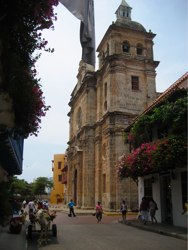 Travel to Colombia – Episode 143
Travel to Colombia – Episode 143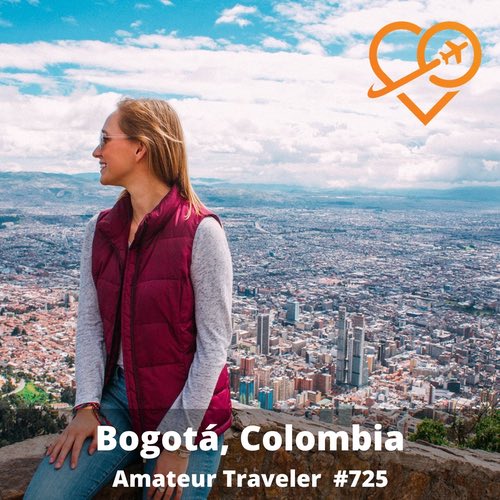 Travel to Bogota, Colombia – Episode 725
Travel to Bogota, Colombia – Episode 725
